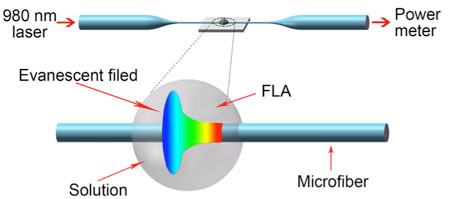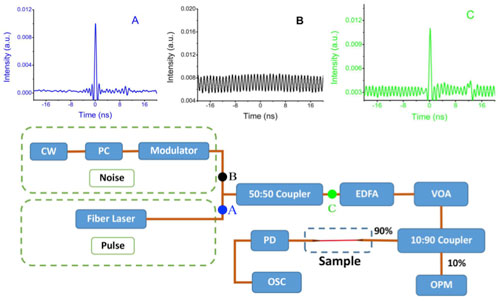| Posted: Mar 23, 2018 | |
Few-layer antimonene decorated microfiber improves optical modulation communication with enhanced long-term stability |
|
| (Nanowerk Spotlight) Ever since the first demonstration of graphene in 2004, a rapid development of two-dimensional (2D) materials has been witnessed. 2D materials have shown many exceptional properties and thus been exploited for diverse potential applications. | |
| In a new study (2D Materials, "Few-layer antimonene decorated microfiber: ultra-short pulse generation and all-optical thresholding with enhanced long term stability"), researchers from Shenzhen University used an antimonene nanosheet to demonstrate all optical modulation in optical signal processing. | |
| In this work, the team synthesized and characterized a mono-elemental, few-layer antimonene through liquid-phase exfoliation and used it to fabricated an antimonene-decorated microfiber with tapered fiber by using evanescent field optical deposition. | |
| To utilize the saturable absorption property of few-layer antimonene, antimonene-decorated microfiber was employed as an optical saturable absorber that can allow for passive mode-locking, Q-switching and all-optical thresholding at the telecommunication band. | |
| These results may provide guidance for the application of antimonene and other Group VA mono-elemental 2D materials in ultra-short pulse generation and all optical thresholding with enhanced long term stability. | |
| Antimonene is considered another novel mono-elemental Group VA 2D material after black phosphorus. Black phosphorus is known for its bandgap dependent feature but suffers from its instability and ease of oxidation under ambient condition. Stabilization strategies have been proposed, but they complicate the fabrication process or alter its intrinsic properties and introduce unwanted defects or scattering loss. | |
| Compared with black phosphorous, the most significant advantage of antimonene comes from its high stability and antioxidant capacity, which plays a critical role in practical applications as optical devices. Few-layer antimonene has been characterized with nonlinear optical response, indicating that few-layer antimonene is potentially useful in ultrafast photonics. | |
| As shown in Fig. 1, few-layer antimonene (FLA), which has been fabricated by liquid-phase exfoliation, can be deposited onto a microfiber to fabricate a few-layer antimonene decorated microfiber device. This device is compatible with fiber-based nonlinear optical systems. | |
 |
|
| Fig. 1 Fabrication of FLA-decorated microfiber: a schematic diagram of the evanescent field method for trapping antimonene nanoflakes on the sidewall of a microfiber. The 980 nm continuous wave laser was used to trap the sample on the microfiber. (Image: Shenzhen Engineering Laboratory of Phosphorene and Optoelectronics) | |
| By incorporating FLA decorated microfiber into a fiber ring laser, mode locking and Q-switching operation can both be realized. In the mode locking regime, pulses centered at 1.55 µm have been obtained with a pulse width of ~550 fs and intra-cavity pulse energies of 60 picojoules. In the Q-switching regime, tunable pulses repetition rate of ranges from 20-50 kHz was observed. | |
| All-optical thresholding is another important application based on the nonlinear optical saturable absorption (SA) effect of the 2D material based device. FLA-decorated microfiber is capable of operating as an optical thresholder for ultrashort pulse shaping. The experimental design of optical thresholding is schematically shown in Fig. 2. | |
| A pulsed laser source based on passive mode locking is used. The pulsed laser source is the same that was used to measure the SA effect of the sample and the pulse train measured by a real-time oscilloscope is shown in Fig. 2A. | |
| A 1 GHz radio frequency modulated low-power light source operating at 1550 nm was employed as a simulated noise source (see Fig. 2B). The pulse source and the noise are then combined together (see Fig. 2C) as a noisy pulse. | |
 |
|
| Fig. 2 Experimental setup diagram of FLA-decorated microfiber as an all-optical thresholder and oscilloscope trace at corresponding points A, B and C. CW: Continuous wave laser source; PC: Polarization controller; EDFA: Erbium-doped fiber amplifier; VOA: Variable optical attenuator; PD: Photodetector; OSC: Real-time oscilloscope; OPM: Optical power meter. (Image: Shenzhen Engineering Laboratory of Phosphorene and Optoelectronics) (click on image to enlarge) | |
| In comparison, the combined noisy pulse is separated by coupler as two paths: one path passing through the sample which will experience the SA effect and the other one directly introduced into the detection system (green point C in Fig. 2). | |
| Based on the SA effect, optical pulses with a high peak power, which is different from the noise, will experience less absorption by FLA-decorated microfiber. In other words, noise in the pulses will be absorbed by the FLA sample with pulse passing through. | |
| As a result, optical pulses passing through the FLA sample are expected with an enhanced signal-to-noise ratio. | |
| To measure the absorption strength of the sample under different input power, an erbium doped fiber amplifier combined with a variable optical attenuator was adopted to modulate the input power into the sample. A 10% output was connected to the optical power meter to monitor the input power on the sample. Signal-to-noise ratio of the pulse after passing through the FLA sample is compared with SNR of the pulse at point C in Fig. 2. | |
| The performance of the FLA-decorated microfiber as an optical thresholder can be simply investigated by measuring the signal-to-noise ratio enhancement of the input pulses after passing through the sample. By properly tuning the attenuation of the optical attenuator, the signal-to-noise ratio enhancement of the optical pulses is measured. The signal-to-noise ratio of the transmitted signal can be improved by as much as ~10 dB. | |
|
Provided by Shenzhen Engineering Laboratory of Phosphorene and Optoelectronics, Shenzhen University, as a Nanowerk exclusive.
|
|
|
Become a Spotlight guest author! Join our large and growing group of guest contributors. Have you just published a scientific paper or have other exciting developments to share with the nanotechnology community? Here is how to publish on nanowerk.com. |
|
